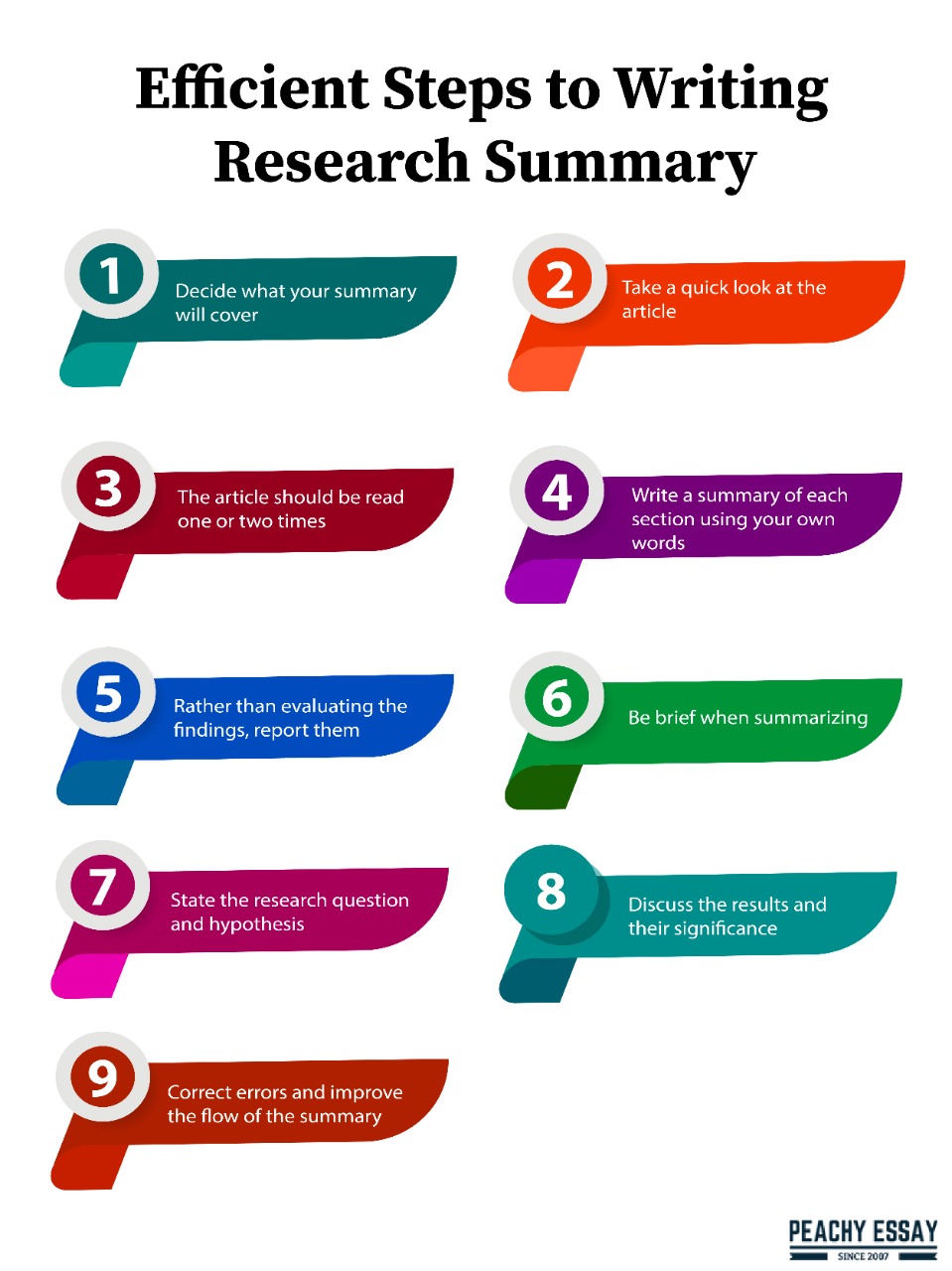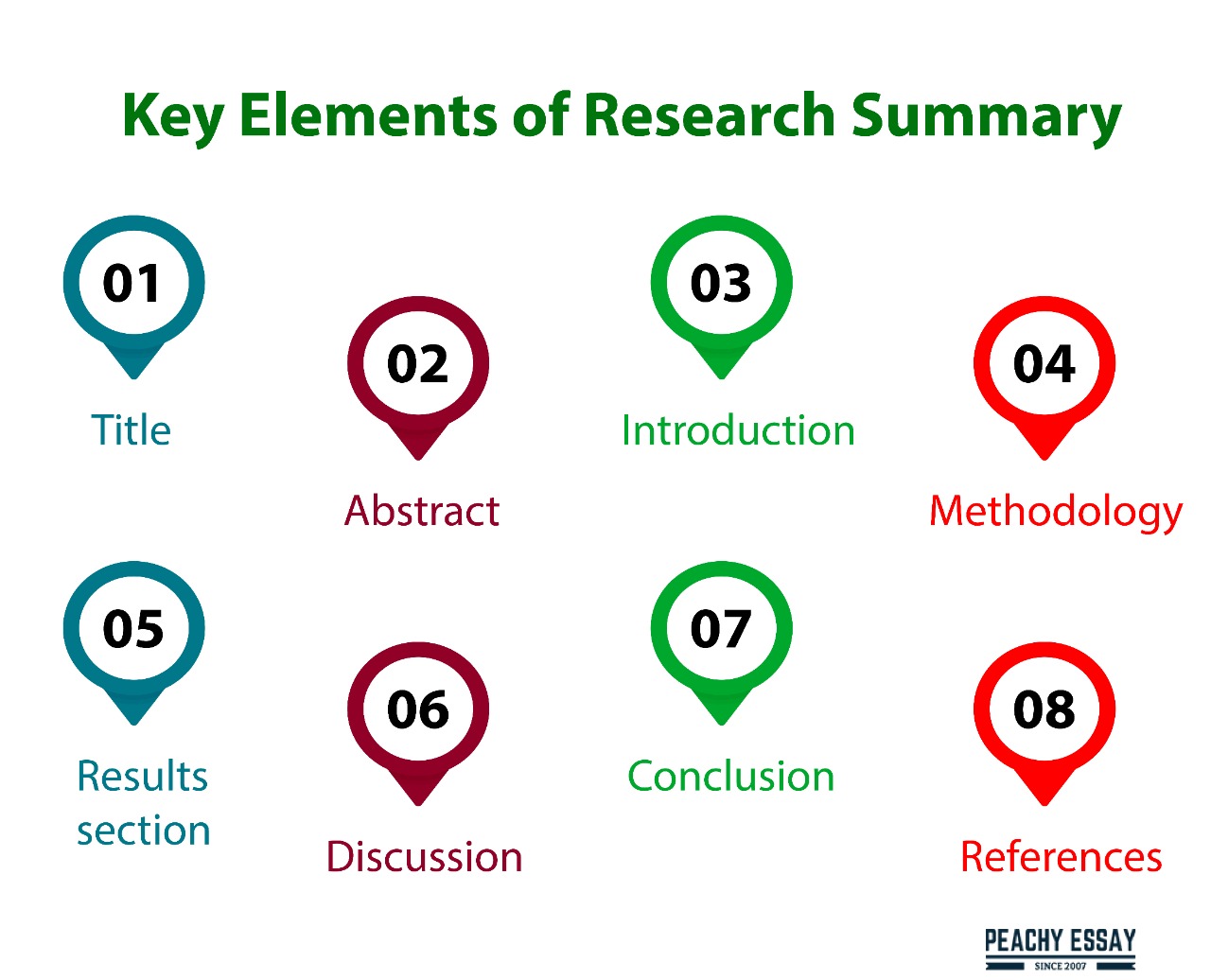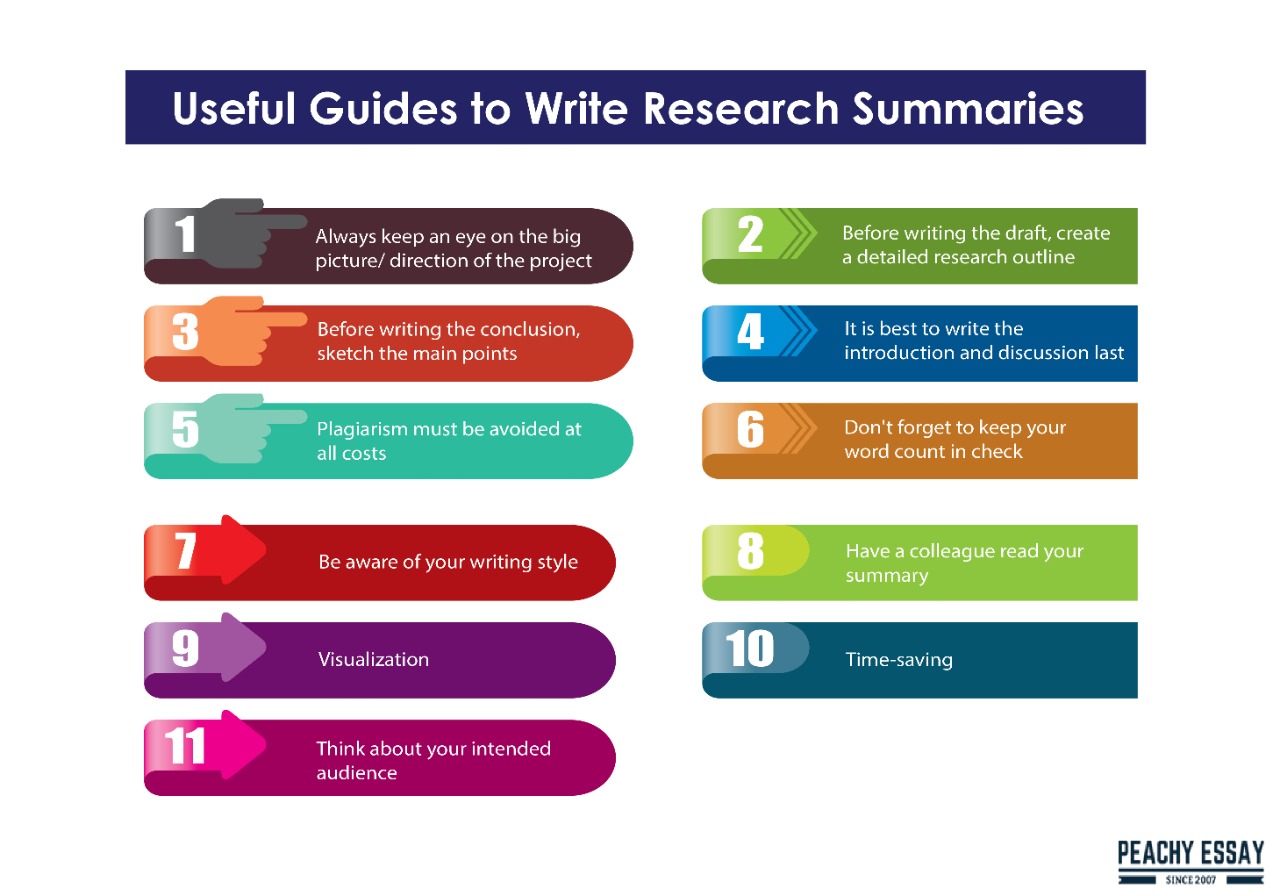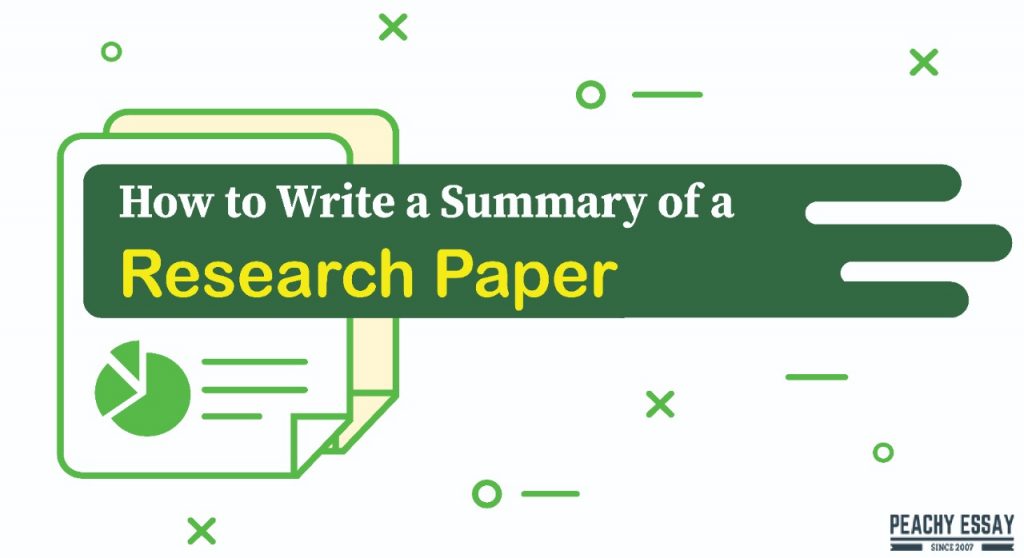Summarizing a research paper is a skill that shows you are knowledgeable about all the information presented. It can be difficult to write a summary since you must remain objective and ignore analysis and criticism. When you read a research paper and keep your goal in mind, you can generate a concise, accurate description of the paper that proves you understand the main conclusions.
In most cases, research articles use standard formats to communicate any experimental data in an organized manner. It is typical for a research article to have a title, an abstract, an introduction, a methodology, results, a discussion, and some references.
Writing a summary of the research paper will mean knowing how to go about it from beginning to end. To come up with an excellent article summary, you need to consider every detail. Custom research paper writing services can be quite helpful, but here are some ways you can do it yourself.
This article will provide insights into how to write a research paper summary.
What is a Research Summary?
A research summary is a report concisely describing a study, usually an article in a peer-reviewed academic journal. University students often encounter this type of task. Through the summary, students can understand and interact with scientific literature and academic papers, which are a key means by which new ideas and theories are communicated to experts in various fields. An article summarization typically preserves the structure and the sections of the full article.
The Purpose of the Research Summary
Writing a research summary is considered a professional academic activity. Summaries are used to explain various types of research to potential audiences. An author provides an overview of the whole study in his or her research summary.
Essentially, is it just a summarization of the original file? Research summaries may seem like an easy task, but they are among the most demanding academic assignments. To write a high-quality paper, you must prioritize the most important research findings and synthesize them for the reader (or readers).
In your presentation, you should give a brief but thorough explanation of the information you choose.
An effective summary must highlight the important outcomes of the original file while enticing readers to continue reading. Research summaries serve as an introduction to the major research studies.
Steps for Writing a Research Summary
Here are some clear steps to help you avoid common mistakes and productivity bottlenecks, enabling you to be more efficient while writing:

Decide what your summary will cover
The first thing you need to do is decide why you are writing that specific summary. Making your summary slightly longer might be the best option for you if you want to refer back later to the content of the article. If, on the other hand, the summary was written to be incorporated into the paper you are currently writing, you may wish to stay focused on how this particular article relates to it.
Take a quick look at the article
The purpose of this is to get an overview of the content addressed in each section and to understand the relative importance of the content, such as the importance of each line of evidence (this will help you identify which sections you should focus on more when reading in detail). Before reading the article, be sure you understand the assignment and your professor’s specifications. Additionally, you can decide if you want to write a summary by yourself or hire a company that offers research paper writing services instead.
The article should be read one or two times
Take the time to read through your research paper cover to cover at least once. If you don’t comprehend any information, read it through again until you can follow it. It is impossible to write a summary of a paper if you don’t understand it.
The initial reading may take you an hour or more, depending on the length and density of the paper.
Make important points stand out with underlining or highlighting:
Afterward, you can come back to it and decide what you want to include in your summary. The importance of the points can depend on the reason for using your summary and the purpose of the paper.
When the authors discuss their findings and conclusions, the important information will usually be found toward the end of the paper.
Write a summary of each section using your own words
After reading, make notes explaining the main points of each section. If you’re going to write an entire summary, you need to make sure you’re writing in your own words. Write down your most important ideas and come back to them later.
It is extremely important to write a summary without plagiarizing or copying the paper. By writing notes in your own words, you will convey information in your own manner.
Rather than evaluating the findings, report them
You can easily turn a summary into an analysis of the paper if you’ve already written research papers. In summary writing, however, you should not add analysis or criticism to the paper or methodology but report on the findings.
Using the example “The methods used in this study are faulty, and further testing is required to suggest conclusions.” is an analysis.
Summary: “This paper utilized an in-depth survey and an interview with each candidate.”.
Be brief when summarizing
Your summary may vary in length depending on the information you’re summarizing. The average summary is 1 to 2 paragraphs long. An overview that’s any longer than that runs the risk of becoming ineffective and hard to read quickly.
Depending on your professor’s specifications, a summary for class may or may not be long enough.
It is even possible to write a summary in one sentence.
State the research question and hypothesis
It would be best if you summarized the authors’ aim and hypothesis to begin your summary. A summary can be opened up with the question and the hypothesis combined into one sentence. A good example is:
Environmental conditions threaten frogs and toads in North Carolina.
Discuss the results and their significance
Explain briefly in your summary what the authors found in their paper and what conclusions they reached. In the case of inconclusive results, be sure to point that out.
For example:
According to Smith and Herman (2008), declining greenhouse gas emissions could reestablish frog and toad populations within 20 years, and climate model projections support this claim.
If you wish, you can include the names of the authors and the year of publication during your summary.
Correct errors and improve the flow of the summary
You should review your summary to look for spelling errors or misleading information. Make sure your writing is clear and ask yourself whether you would understand it if you never read the original.
It would be helpful to read your summary to someone who hasn’t read the article and see if they understand the main points.
Structure of the Research Summary
The summary is similar to that in the original paper (just condensed) in terms of the format. Regardless of whether corresponding headings appear or not, all sections should be covered and considered. Here are the key elements of any research summary:

Title
This announces the precise topic/area of analysis and briefly mentions the key finding(s) or argument(s) presented.
Abstract
A concise, thorough, and comprehensive summary of the study can typically be found in any academic article (the length varies greatly, normally between 100-500 words). The abstract of a research summary is likely to be much shorter than that of an academic article.
Introduction
As a part of any research summary, this provides essential context (the literature review) for readers to understand the subject by summarizing the current state of the investigation, emphasizing an important concept or definition, etc. Additionally, this section might specify the importance of the subject (or not, if the value is obvious).
Last but not least, an introduction normally lays out the investigation questions and hypotheses advanced by authors, which are then described more fully in any research summary (it is only possible to do so after identifying the elements of the original paper).
Methodology
Irrespective of where this section is located, it details experimental methods or data analysis methods (for example, types of experiments, surveys, sampling, or statistical analysis). Research summaries often omit many of these details, so it’s important to know what’s most important to mention.
Results section
Detailed evidence for all experiments is listed here, along with some of the primary data analysis, observations, conclusions, and primary interpretations. As the section that typically occupies the most space in an analysis paper, it must be carefully rewritten, meaning that it must be understood which content to eliminate and keep.
Discussion
The discussion here refers to how the results are sent into the current knowledge among experts. In this section, you can find explanations of the results, theoretical models explaining the study’s findings, strengths, and weaknesses, complementary further exploration to be undertaken, findings, etc. These are all significant elements that need to be included in the summary.
Conclusion
Originally, this section may have been absent or integrated with the Discussion. It might be necessary to treat this section as a separate section in certain research summary instructions. In conclusion, hypotheses are reexamined and either validated or discounted depending on how strong the evidence is (important lines of evidence could be highlighted).
References
Those cited works should be mentioned in this section, and citations must be included at the very least for the original article (this is typically enough). When you are also required to provide your critical opinion (and new evidence unrelated to the subject), mentioning other works might be relevant.
How Long is a Research Summary?
An average summary should be between 200-350 words long, but you should confirm this with your supervisor. In addition, it generally follows an introduction-body-conclusion structure.
Writing Tips for Research Summaries
The following is a guide to writing research summaries that can be useful:

Always keep an eye on the big picture/ direction of the project
The original article should have provided you with a robust and cohesive picture of the story. You may find it helpful to read it several times quickly to review the declared goals, hypotheses, key evidence, and conclusions – this provides a constant sense of direction to ensure that no statement is misplaced. Performing this step even after writing a fourth, a third, or half of the paper can be useful (to ensure that deviations are not made).
Before writing the draft, create a detailed research outline
When structuring your paper, you might find it useful. Structure your paper more effectively by using a research summary template.
Before writing the conclusion, sketch the main points
This is useful for many reasons: validating or invalidating hypotheses, reiterating supporting or demolishing evidence, noting potential implications of what you’ve said, pointing out study limitations, and presenting ideas for future research. Having them written down and ready bits of help include all of them.
It is best to write the introduction and discussion last
It is a good idea to list hypotheses, goals, questions, and primary results first. In the latter, the content of the introduction and discussion can be changed as required (e.g., to match a preset word limit). Apart from that, you should follow the natural order.
Plagiarism must be avoided at all costs
It is very tempting to steal quotes or whole sentences from articles, given how well-written they are, but you should not plagiarize (pardon copy-pasting, but paraphrasing should only be used when necessary). Developing your own thoughts from scratch is the best way to stay safe.
Don’t forget to keep your word count in check
It’s better to keep your summary short than the original paper (just rewritten). Additionally, you may be required to adhere to a word count limit, which means you must be careful about how much you write in each section.
Make sure your work is free of grammatical, spelling, and wordiness mistakes.
Our subject headings, headings, subheadings, etc., may be converted to the case you prefer.
Be aware of your writing style
You must summarize content impersonally, precisely, and purely evidence-based. Personal views/attitudes should only be expressed in the critical section (if necessary).
Have a colleague read your summary
Make sure the person can comprehend everything without reading the article – this will help ensure that you haven’t missed any important content, explanations, concepts, etc.
Visualization
A good paper doesn’t just consist of writing long words about some subject and analyzing what you find, but both the research and its summary need to have visuals to make a strong impact. It is sometimes easy to convey a lot of information using a simple chart or diagram. Many students leave visuals in the original file and omit them in summary. Don’t hesitate to include images, tables, and other visual aids with this paper.
Time-saving
Creating a research summary takes more time; one cannot do it in an hour. In some cases, students spend five or six hours summarizing their research. If you scan the paper from top to bottom before writing, you can finish the task faster than if you break it down piece by piece. You will determine what to include in the summary if you read everything you’ve written, from the abstract to the conclusion. It may be appropriate to omit the literature review summary, but this depends on who you are targeting.
Think about your intended audience
Considering your target audience is a golden rule of writing, and the research summary is no exception. The target audience has different needs, and your paper should take that into account. Who are you writing for? By writing down the answer, you can identify research articles for your summary.




